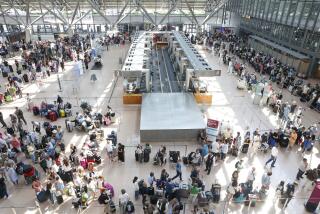Quake outage may be sign of fragile network
- Share via
SINGAPORE — A few seconds of undersea quaking was all it took to cause massive telecommunications disruptions throughout tech-savvy Asia, where Internet services slowed or stopped, phone lines went dead and financial transactions ground to a halt.
Analysts and industry insiders said the service disruption -- caused by the rupture of two undersea data transmission cables in Tuesday’s earthquake off Taiwan -- was a sign of the vulnerability of the world’s telecommunications network, which was frenetically built at the height of the Internet boom but has since attracted little investment.
However, activity is picking up, and the quake outage could open eyes to the need for more backup links.
“We are so accustomed to being connected at all points that it does shock people when suddenly it’s no longer there,” said telecommunications analyst Tim Dillon. “Particularly in this region, which is tremendously connected in terms of mobile [phone], data and Internet use.”
On Thursday, long-distance telephone connections were elusive and Internet speeds remained slow -- and in some areas nonexistent -- in Taiwan, Hong Kong, Japan, China, Singapore and South Korea. It is expected to take weeks to fully repair the links.
“I haven’t experienced anything like this before,” said Francis Lun, general manager at Fulbright Securities, one of many Hong Kong financial firms that were forced to conduct business by telephone Wednesday.
“We’ve become too dependent on these optic fibers -- a few of them get damaged, and everything collapses. Many lost the opportunity to make fast money.”
Breaks in the undersea cables are not uncommon -- the culprits include earthquakes, volcanoes, fishing trawlers, ship anchors and nibbling sharks. For this reason, fiber links are generally built as loops.
For instance, FLAG Telecom’s North Asia Loop runs undersea from Hong Kong to Taiwan to Korea to Japan, then takes another route back to Hong Kong. If one link in the loop breaks, data will automatically be switched to flow the other way around the ring, and customers ideally would not even notice a change.
Outages occur when too many links break at the same time on too many rings. The sea bottom south of Taiwan, where the earthquake occurred, may have a dozen cables running in a relatively small area.
Part of the problem with this week’s break may have been that a number of providers in Hong Kong and Southeast Asia may have rerouted U.S.-bound traffic through Europe to avoid the cut south of Taiwan. But there is just a handful of cables leading west.
“The cable routes to Europe are overcrowded,” said Dillon, senior research director with Sterling, Va.-based Current Analysis Inc., which studies the telecom industry.
More to Read
Sign up for Essential California
The most important California stories and recommendations in your inbox every morning.
You may occasionally receive promotional content from the Los Angeles Times.













